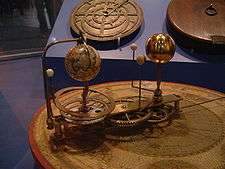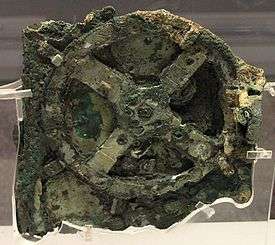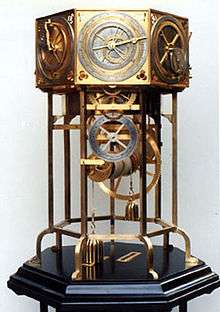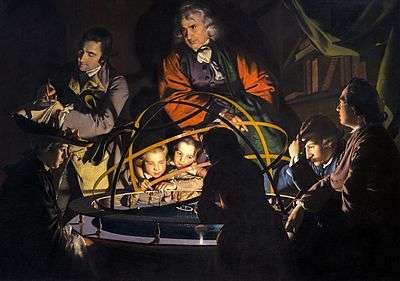Orrery

An orrery is a mechanical model of the solar system that illustrates or predicts the relative positions and motions of the planets and moons, usually according to the heliocentric model. It may also represent the relative sizes of these bodies; but since accurate scaling is often not practical due to the actual large ratio differences, a subdued approximation may be used instead. Though the Greeks had working planetaria, the first orrery that was a planetarium of the modern era was produced in 1704, and one was presented to Charles Boyle, 4th Earl of Orrery – whence came the name. They are typically driven by a clockwork mechanism with a globe representing the Sun at the centre, and with a planet at the end of each of the arms.
History
Early versions


%2C_Eberhard_Baldewein_et_al%2C_Marburg-Kassel%2C_1563-1568_-_Mathematisch-Physikalischer_Salon%2C_Dresden_-_DSC08057.jpg)
The Antikythera mechanism, discovered in 1900 in a wreck off the Greek island of Antikythera and extensively studied, exhibited the diurnal motions of the Sun, Moon, and the five known planets. It has been dated between 150 and 100 BC. The Antikythera hand driven mechanism is now considered one of the first orreries, but for many decades was ignored as it was thought to be far too complex to be genuine.[1] It was geocentric and used as a mechanical calculator designed to calculate astronomical positions.
According to Cicero, the Roman philosopher who was writing in the first century BC, Posidonius constructed a planetary model.
In 1348, Giovanni Dondi built the first known clock driven mechanism which displays the ecliptical position of Moon, Sun, Mercury, Venus, Mars, Jupiter and Saturn according to the complicated ptolemeic planetary theories.[2][3] The clock itself is lost, but Dondi left a complete description of the astronomic gear trains of his clock.
As late as 1650, P. Schirleus built a geocentric planetarium with the Sun as a planet, and with Mercury and Venus revolving around the Sun as its moons.[4]
At the court of William IV, Landgrave of Hesse-Kassel two complicated astronomic clocks were built in 1561 and 1563-1568, which show on four sites the ecliptical position of Sun, Mercury, Venus, Mars, Jupiter and Saturn, the Moon, Sun and Dragon (Nodes of the Moon) according to Ptolemy, a Calendar, the Sunrise and Sunset and an automated celestial sphere with an animated Sun symbol which, for the first time on a celestial globe, show the real position of the sun, including the equation of time.[5][6] The clocks are now on display in Kassel at the Astronomisch-Physikalisches Kabinett and in Dresden at the Mathematisch-Physikalischer Salon.
In De revolutionibus orbium coelestium, published in Nuremberg in 1543, Nicolaus Copernicus challenged the Western teaching of a geocentric universe in which the Sun revolved daily around the Earth. He observed that some Greek philosophers had proposed a heliocentric universe. This simplified the apparent epicyclic motions of the planets, making it feasible to represent the planets' paths as simple circles. This could be modelled by the use of gears. Tycho Brahe's improved instruments made precise observations of the skies (1576–1601), and from these Johannes Kepler (1621) deduced that planets orbited the Sun in ellipses. In 1687 Isaac Newton explained the cause of elliptic motion in his theory of gravitation.[7]
Modern orreries

Clock makers George Graham and Thomas Tompion built the first modern orrery around 1704 in England.[8] Graham gave the first model, or its design, to the celebrated instrument maker John Rowley of London to make a copy for Prince Eugene of Savoy. Rowley was commissioned to make another copy for his patron Charles Boyle, 4th Earl of Orrery, from which the device took its name in English.[9] This model was presented to Charles' son John, later the 5th Earl of Cork and 5th Earl of Orrery. Independently, Christiaan Huygens published details of a heliocentric planetary machine in 1703, which he built while resident in Paris between 1665 and 1681. He calculated the gear trains needed to represent a year of 365.242 days, and used that to produce the cycles of the principal planets.[4]
Joseph Wright's painting A Philosopher giving a Lecture on the Orrery in which a lamp is put in place of the Sun (ca. 1766), which hangs in Derby Museum and Art Gallery, depicts a group listening to a lecture by a natural philosopher. The Sun in a brass orrery provides the only light in the room. The orrery depicted in the painting has rings, which give it an appearance similar to that of an armillary sphere. The demonstration was thereby able to depict eclipses.[10]
To put this in chronological context, in 1762 John Harrison's marine chronometer first enabled accurate measurement of longitude. In 1766, astronomer Johann Daniel Titius first demonstrated that the mean distance of each planet from the Sun could be represented by the following progression:
That is, 0.4, 0.7, 1.0, 1.6, 2.8, 5.2 ... The numbers refer to astronomical units, the mean distance between Sun and Earth, which is 1.496 × 10⁸ km (93 × 10⁶ miles). The Derby Orrery does not show mean distance, but demonstrated the relative planetary movements.
Eisinga's Planetarium was built from 1774 to 1781 by Eise Eisinga in his home in Franeker, in the Netherlands. It displays the planets across the width of a room's ceiling, and has been in operation almost continually since it was created.[11] This orrery is a planetarium in both senses of the word: a complex machine showing planetary orbits, and a theatre for depicting the planets' movement. Eisinga house was bought by the Dutch Royal family who gave him a pension.

In 1764, Benjamin Martin devised a new type of planetary model, in which the planets were carried on brass arms leading from a series of concentric or coaxial tubes. With this construction it was difficult to make the planets revolve, and to get the moons to turn around the planets. Martin suggested that the conventional orrery should consist of three parts: the planetarium where the planets revolved around the Sun, the tellurion (also tellurian or tellurium) which showed the inclined axis of the Earth and how it revolved around the Sun, and the lunarium which showed the eccentric rotations of the Moon around the Earth. In one orrery, these three motions could be mounted on a common table, separately using the central spindle as a prime mover.[1]
Explanation
All orreries are planetariums or planetaria (alternative plural). The term orrery has only existed since 1714. A grand orrery is one that includes the outer planets known at the time of its construction. The word planetarium has been captured, and now usually refers to hemispherical theatres in which images of the night sky are projected onto an overhead surface. Planetariums (orreries) can range widely in size from hand-held to room-sized. An orrery is used to demonstrate the motion of the planets, while a mechanical device used to predict eclipses and transits is called an astrarium.
An orrery should properly include the Sun, the Earth and the Moon (plus optionally other planets). A model that only includes the Earth, the Moon and the Sun is called a tellurion or tellurium, and one which only includes the Earth and the Moon is a lunarium. A jovilabe is a model of Jupiter and its moons.[12]
| Planet | Avg. Distance from Sun | Diameter | Mass | Density | No. of moons | Orbital period (years) | Inclination to ecliptic | Axial tilt | Rotational period (sidereal) |
|---|---|---|---|---|---|---|---|---|---|
| Mercury | 0.39 AU | 0.38 Earth diameter | 0.05 Earth mass | 5.5 g/cm³ | 0 | 0.24 | 7.0 | 0 | 59 days |
| Venus | 0.72 | 0.95 | 0.82 | 5.3 | 0 | 0.62 | 3.4 | 177 | -243 days |
| Earth | 1.00 | 1.00 | 1.00 | 5.5 | 1 | 1.00 | 0 | 23 | 23.9 hours |
| Mars | 1.52 | 0.53 | 0.11 | 3.9 | 2 | 1.88 | 1.9 | 25 | 24.5 hours |
| Jupiter | 5.20 | 11.21 | 317.9 | 1.3 | 67 | 11.9 | 1.3 | 3 | 10 hours |
| Saturn | 9.54 | 9.45 | 95.2 | 0.7 | 62 | 29.5 | 2.5 | 27 | 11 hours |
| Uranus | 19.2 | 4.01 | 14.5 | 1.3 | 27 | 84 | 0.8 | 98 | -17 hours |
| Neptune | 30.1 | 3.88 | 17.1 | 1.6 | 14 | 165 | 1.8 | 28 | 16 hours |
| Pluto | 39.4 | 0.18 | 0.002 | 2 | 5 | 248 | 17.1 | 122 | -6.4 days |
A planetarium will show the orbital period of each planet and the rotation rate, as shown in the table above. A tellurion will show the earth with the moon revolving around the sun. It will use the angle of inclination of the equator from the table above to show how it rotates around its own axis. It will show the earth's moon, rotating around the earth.[13] A lunarium is designed to show the complex motions of the moon as it revolves around the earth.
Orreries are usually not built to scale. Some fixed Solar System scale models have been built and are often many kilometres in size. Human orreries, where humans move about as the planets, have also been constructed, but most are temporary. There is a permanent human orrery at Armagh Observatory in Northern Ireland, which has the six ancient planets, Ceres, and comets Halley and Encke. Uranus and beyond are also shown, but in a fairly limited way. Another is at Sky's the Limit Observatory and Nature Center in Twentynine Palms, CA. This is a true to scale (20 billion to one), true to position (accurate to within four days) human orrery. The first four planets are relatively close to one another, but the next four require a certain amount of hiking in order to visit them.
A normal mechanical clock could be used to produce an extremely simple orrery with the Sun in the centre, Earth on the minute hand and Jupiter on the hour hand; Earth would make 12 revolutions around the Sun for every 1 revolution of Jupiter. Note however that Jupiter's actual year is 11.86 Earth years long, so this particular example would lose accuracy rapidly. A real orrery would be more accurate and include more planets, and would perhaps make the planets rotate as well.
Projection orreries
Many planetariums (buildings) have a projection orrery, which projects onto the dome of the planetarium a Sun with either dots or small images of the planets. These usually are limited to the planets from Mercury to Saturn, although some include Uranus. The light sources for the planets are projected onto mirrors which are geared to a motor which drives the images on the dome. Typically the Earth will circle the Sun in one minute, while the other planets will complete an orbit in time periods proportional to their actual motion. Thus Venus, which takes 224.7 days to orbit the Sun, will take 37 seconds to complete an orbit on an orrery, and Jupiter will take 11 minutes, 52 seconds.
Some planetariums have taken advantage of this to use orreries to simulate planets and their moons. Thus Mercury orbits the Sun in 0.24 of an Earth year, while Phobos and Deimos orbit Mars in a similar 4:1 time ratio. Planetarium operators wishing to show this have placed a red cap on the Sun (to make it resemble Mars) and turned off all the planets but Mercury and Earth. Similar tricks can be used to show Pluto and its five moons.
Notable orreries
.jpg)
Shoemaker John Fulton of Fenwick, Ayrshire, built three between 1823 and 1833. The last is in Glasgow's Kelvingrove Art Gallery and Museum.
The Franeker Planetarium built by a wool carder named Eise Eisinga in his own living room, in the small city of Franeker in Friesland, is in fact an orrery. It was constructed between 1774 and 1781. The "face" of the model looks down from the ceiling of a room, with most of the mechanical works in the space above the ceiling. It is driven by a pendulum clock, which has 9 weights or ponds. The planets move around the model in real time.[14]
An innovative concept is to have people play the role of the moving planets and other Solar System objects. Such a model, called a human orrery, has been laid out with precision at the Armagh Observatory.
Meccano Planetaria
The first Meccano Orrery was described in June 1918 Meccano Manual, though it is in the last quarter of the 20th century that Alan Partridge, John Nuttall, Pat Briggs and Michael Whiting have experimented with the limitations and possibilities of this medium. There are six methods of building orreries:[15]
- Telescopic concentric tubing, though the tubing is not a Meccano part. For a full 9-planet system, 18 concentric tubes and 19 geared motions are needed
- Nested hollow turntables with internal gearing. A 1984 Jovilabe showing Jupiter and the 14 then known moons required 14 turntables and 324 gears; it is accurate to within 0.01%
- Fixed central rod, with top drive and sun and planet gearing. In this method, the sun drives the first planet and this then drives the second and so on. The errors are thus cumulative, but non-Meccano gearing can keep this within 0.02%
- Fixed central tube, with bottom drive and sun and planet gearing. This removes the need for an overhead gantry, improving the appearance
- Two component epicyclic gearing.
- Fixed Central Rod, Epicyclic gearing, top drive by 'by-pass gearing' from below.
Virtual Orreries

The first virtual Orrery, the York Solar System Model, was constructed over a period of about 6 months at the end of 1999.[16] This scale model of the Solar System is spread out along 6.4 miles of the old East Coast main-line railway. Along it you can find scale models of all the planets in our solar system as well as models of the Cassini and Voyager spacecraft. The Sun is made from 2 fibreglass hemispheres manufactured for a septic tank. A hole was cut into one of the hemisphere and then the two halves were fiber glass together. Next the internal steel work to support the Sun was installed and the sphere sealed before being painted gold. The supporting steel-work was manufactured by Minster Engineering. The foundations were prepared, 10 tons of concrete poured in and finally the finished model was installed.
Another virtual orrery was created in 2013 by Cattle Point Foundation[17] volunteers at Cattle Point DARK SKY Urban Star Park.[18] The orrery is called "The Salish Sea Walk of the Planets".[19] It was built on Google Maps as there was a contentious local issue that the vernal pools by the edge of the Salish Sea, where the globally rare Macoun's Meadowfoam and Victoria Owl-Clover[20] exist, might be damaged by creating cairns and encouraging walkers to explore the Orrery.
As well as highlighting the plight of the rare plants, the Orrery has served to put the spotlight on the Coast Salish and specifically the local clan, the Lkwungen[21] upon whose traditional land Cattle Point Star Park lies.[22]
The same spotlight also illuminates the unique Salish Sea "stories" from several sciences. Biologists recognize that the marine waters off Cattle Point DARK SKY Star Park are critical habitat for the Orcas of the Salish Sea. The sea is also a good habitat for the Giant Pacific Octopus; and, in the Southern Salish Sea, the greatly overfished Pacific Herring - resulting in the relatively low abundance of birds;[23] Ornithologists appreciate the Marbled Murrelets, and Rhinoceros Auklets which are of great interest to visiting birdwatchers especially flying by day and night, in and out of the DARK SKY star park; noting that Cattle Point is surrounded by the historic Victoria Harbour Migratory Bird Sanctuary (est. Oct.27, 1923). This was established to control hunting in 1923, and now harbours amazing urban life; geologists note that the Orrery's SUN sits on top of the Leech River/Devils Mountain fault line ; and archaeologists celebrate the large number of archaeological sites from the SUN to MERCURY (i.e. within the Star park down along the seafront to the mouth of Bowker Creek), all part of an ancient Lkwungen seaport known as Sitchanalth[24] hypothesized to have been destroyed by the great Tsunami of 930AD.[25] The Orrery quickly evolved from being contained within the Star Park, to taking on a size previously unimagined by the volunteers. It is now over 8,500 km (5,300 mi) in size reaching out to communities along the Salish Sea's North West Pacific edge and then up along the West coast of Vancouver Island. As an example, the furthest "planet" PLUTO is located in Bamfield.[26] The most distant "object" in the Solar System is the Oort Cloud and has been positioned (approximately, virtually and symbolically) at the Canadian Embassy in Beijing.[27] This effectively serves to illustrate the enormous distances involved in the solar system. "The Salish Sea Walk of the Planets" name symbolizes the fictional journey of the Coast Salish riding inbound inside a long period Comet from Proxima Centauri to Earth many thousands of years ago.
In popular culture
- A large orrery is a key feature in the climactic scene of the film Lara Croft: Tomb Raider (2001).
- An orrery is used to determine when total eclipses occur in Pitch Black.
- The orrery is an artificial construct consisting of life-sized planets and a sun in Green Lantern: New Guardians.[28]
- The third level of Fireproof Games' popular smartphone game The Room occurs in and around a Talisman Co. Heliocentric Orrery.
- An orrery is one of the rooms in Andrew Plotkin's interactive fiction game The Dreamhold. It contains multiple items vital to completing the game.
- An orrery can be seen on board the spaceship Juggernaut in Prometheus.
- A complex orrery is used in a pivotal scene of The Dark Crystal.
- In Prince of Persia: The Forgotten Sands, the Prince manoeuvers through a gigantic water-powered orrery to get to the other side of one of the palace's towers; it is inaccurately named "the Astrolabe" in-game.
See also
References
- 1 2 Calvert, H.R. (1967). Astronomy: Globes Orreries and other Models. London: H.M.S.O. ASIN B001A9C9SQ.
- ↑ King, Henry C.; Millburn, John R. (1978). Geared to the stars : the evolution of planetariums, orreries, and astronomical clocks. Toronto: University of Toronto Press. pp. 28–41. ISBN 0-8020-2312-6.
- ↑ Lloyd, H. Alan (1958). Some Outstanding Clocks Over Seven Hundred Years. London: Leonard Hill Books Limited. pp. 9–24.
- 1 2 Brewster, David (1830). "Planetary Machines". The Edinburgh Encyclopedia. 16. Edinburgh: William Blackwood et al. p. 624. Retrieved 2011-06-08.
- ↑ Lloyd, Alan (1958). Some Outstanding Clocks Over Seven Hundred Years. Leonard Hill Books Limited. pp. 46–57.
- ↑ Poulle, Emmanuel; Sändig, Helmut; Schardin, Joachim; Hasselmeyer, Lothar (2008). Die Planetenlaufuhr : ein Meisterwerk der Astronomie und Technik der Renaissance geschaffen von Eberhard Baldewein 1563 - 1568 (1ª ed.). Stuttgart: Dt. Gesellschaft für Chronometrie. ISBN 978-3-89870-548-6.
- ↑ Ronan, Colin (1992) [First published 1981]. The Practical Astronomer. London: Bloomsbury Books. pp. 108–112. ISBN 1-85471-047-8.
- ↑ Carlisle, Rodney (2004). Scientific American Inventions and Discoveries, p. 189. John Wiley & Songs, Inc., New Jersey. ISBN 0-471-24410-4.
- ↑ "orrery". Oxford English Dictionary (3rd ed.). Oxford University Press. September 2005. (Subscription or UK public library membership required.)
- ↑ "Revolutionary Players". Search.revolutionaryplayers.org.uk. Retrieved 2010-02-09.
- ↑ http://www.planetarium-friesland.nl/en
- ↑ Pentz, M.J. (1971). The Earth, Its Shape, Internal Structure and Composition. OU_S100_22. Bletchley: Open University Press. ISBN 978-0-335-02034-8.
- ↑ "Adler Planetarium:Research& Collections". 1300 South Lake Shore Drive • Chicago IL 60605: Adler Planetarium. 2010. Retrieved 22 June 2011.
- ↑ Sixma, H (November 1934). "The Franeker Planetarium". Popular Astronomy. SAO/NASA ADS. XLII (9): 489–495. Bibcode:1934PA.....42..489S. Retrieved 2011-06-22.
- ↑ Whiting, Michael (2007). "Orrery Developments:The Use of Meccano in Constructing Planetaria" (PDF). Bulletin of the Scientific Society (94). Retrieved 2011-06-08.
- ↑
- ↑ Foundation, Cattle Point. "Cattle Point Foundation". Cattle Point Foundation. Cattle Point Foundation. Retrieved 26 January 2016.
- ↑ Cattle Point, Star Park. "Cattle Point DARK SKY Urban Star Park". Cattle Point DARK SKY Urban Star Park. Cattle Point Foundation. Retrieved 26 January 2016.
- ↑ "The Salish Sea Walk of the Planets". The Salish Sea Walk of the Planets. Cattle Point Foundation. Retrieved 27 January 2016.
- ↑ Castilleja victoriae. "COSEWIC assessment and status report on the Victoria Owl-Clover in Canada" (PDF). Committee on the Status of Endangered Wildlife in Canada. Retrieved 27 January 2016.
- ↑ Sam, Brenda and Cheryl Bryce. "Traditional Territories of the Lekwungen". Coast Salish Collections. Retrieved 29 January 2016.
- ↑ Lutz, John Sutton. "Dr." (PDF). UVIC. University of Victoria. Retrieved 29 January 2016.
- ↑ "Marine Species at Risk". EPA Salish Sea Report. United States Environmental Protection Agency. Retrieved 29 January 2016.
- ↑ Keddie, Grant (2003). A History of the Songhees People as Seen by Outsiders (1790–1912). Victoria, BC, Canada: RBCM Publications. ISBN 978-0-7726-4964-5. Retrieved 29 January 2016.
- ↑ Doughton, Sandi. "Ancient quake and tsunami in Puget Sound shake researchers". The Seattle Times. Retrieved 29 January 2016.
- ↑ Smith, William. "Bamfield". Google MyMaps. Google. Retrieved 29 January 2016.
- ↑ Smith, William. "Oort Cloud in Beijing". Google Maps. Google. Retrieved 29 January 2016.
- ↑ New Guardians #4-6 (Dec 2011 - Feb 2012)
External links
| Wikimedia Commons has media related to Orreries. |
- JPL Solar System Simulator
- Armagh Observatory Human Orrery
- Long Now Foundation Orrery
- University of Pennsylvania Orrery
- Sky's the Limit Observatory Orrery
- The Salish Sea Walk of the Planets